sensor CADILLAC STS 2006 1.G Owner's Manual
[x] Cancel search | Manufacturer: CADILLAC, Model Year: 2006, Model line: STS, Model: CADILLAC STS 2006 1.GPages: 480, PDF Size: 2.74 MB
Page 380 of 480
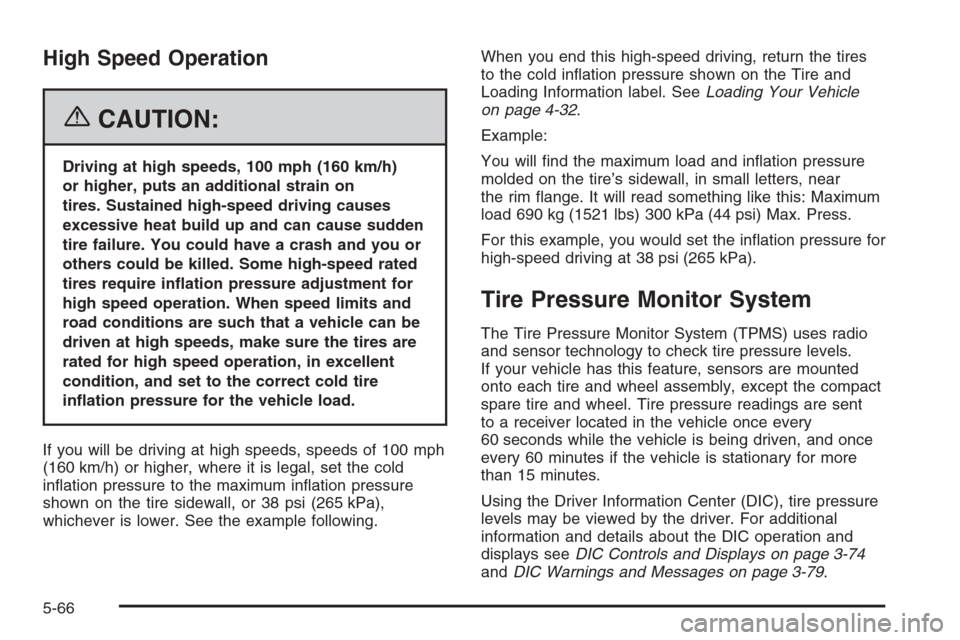
High Speed Operation
{CAUTION:
Driving at high speeds, 100 mph (160 km/h)
or higher, puts an additional strain on
tires. Sustained high-speed driving causes
excessive heat build up and can cause sudden
tire failure. You could have a crash and you or
others could be killed. Some high-speed rated
tires require in�ation pressure adjustment for
high speed operation. When speed limits and
road conditions are such that a vehicle can be
driven at high speeds, make sure the tires are
rated for high speed operation, in excellent
condition, and set to the correct cold tire
in�ation pressure for the vehicle load.
If you will be driving at high speeds, speeds of 100 mph
(160 km/h) or higher, where it is legal, set the cold
in�ation pressure to the maximum in�ation pressure
shown on the tire sidewall, or 38 psi (265 kPa),
whichever is lower. See the example following.When you end this high-speed driving, return the tires
to the cold in�ation pressure shown on the Tire and
Loading Information label. SeeLoading Your Vehicle
on page 4-32.
Example:
You will �nd the maximum load and in�ation pressure
molded on the tire’s sidewall, in small letters, near
the rim �ange. It will read something like this: Maximum
load 690 kg (1521 lbs) 300 kPa (44 psi) Max. Press.
For this example, you would set the in�ation pressure for
high-speed driving at 38 psi (265 kPa).
Tire Pressure Monitor System
The Tire Pressure Monitor System (TPMS) uses radio
and sensor technology to check tire pressure levels.
If your vehicle has this feature, sensors are mounted
onto each tire and wheel assembly, except the compact
spare tire and wheel. Tire pressure readings are sent
to a receiver located in the vehicle once every
60 seconds while the vehicle is being driven, and once
every 60 minutes if the vehicle is stationary for more
than 15 minutes.
Using the Driver Information Center (DIC), tire pressure
levels may be viewed by the driver. For additional
information and details about the DIC operation and
displays seeDIC Controls and Displays on page 3-74
andDIC Warnings and Messages on page 3-79.
5-66
Page 381 of 480
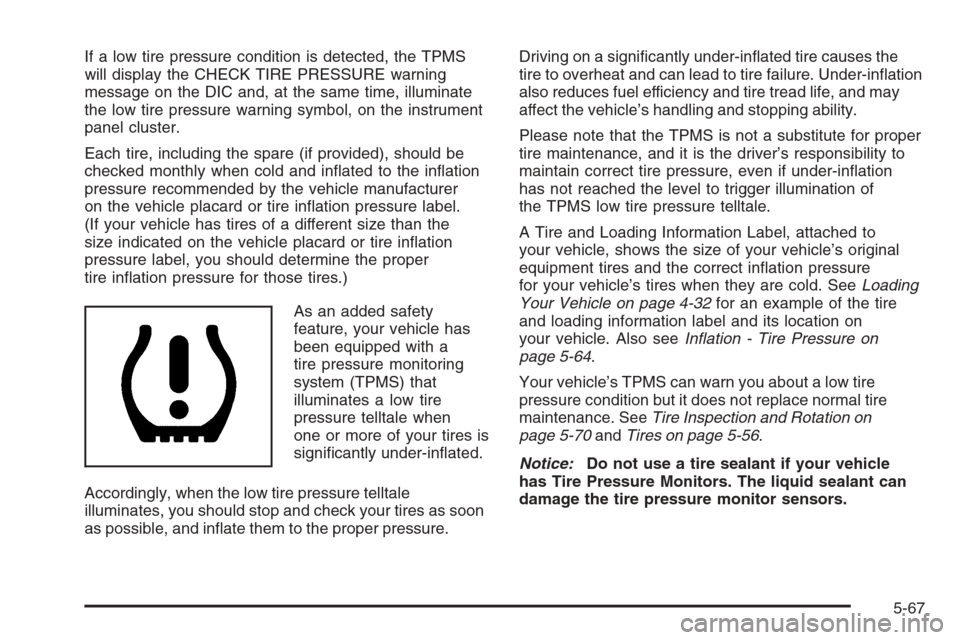
If a low tire pressure condition is detected, the TPMS
will display the CHECK TIRE PRESSURE warning
message on the DIC and, at the same time, illuminate
the low tire pressure warning symbol, on the instrument
panel cluster.
Each tire, including the spare (if provided), should be
checked monthly when cold and in�ated to the in�ation
pressure recommended by the vehicle manufacturer
on the vehicle placard or tire in�ation pressure label.
(If your vehicle has tires of a different size than the
size indicated on the vehicle placard or tire in�ation
pressure label, you should determine the proper
tire in�ation pressure for those tires.)
As an added safety
feature, your vehicle has
been equipped with a
tire pressure monitoring
system (TPMS) that
illuminates a low tire
pressure telltale when
one or more of your tires is
signi�cantly under-in�ated.
Accordingly, when the low tire pressure telltale
illuminates, you should stop and check your tires as soon
as possible, and in�ate them to the proper pressure.Driving on a signi�cantly under-in�ated tire causes the
tire to overheat and can lead to tire failure. Under-in�ation
also reduces fuel efficiency and tire tread life, and may
affect the vehicle’s handling and stopping ability.
Please note that the TPMS is not a substitute for proper
tire maintenance, and it is the driver’s responsibility to
maintain correct tire pressure, even if under-in�ation
has not reached the level to trigger illumination of
the TPMS low tire pressure telltale.
A Tire and Loading Information Label, attached to
your vehicle, shows the size of your vehicle’s original
equipment tires and the correct in�ation pressure
for your vehicle’s tires when they are cold. SeeLoading
Your Vehicle on page 4-32for an example of the tire
and loading information label and its location on
your vehicle. Also seeIn�ation - Tire Pressure on
page 5-64.
Your vehicle’s TPMS can warn you about a low tire
pressure condition but it does not replace normal tire
maintenance. SeeTire Inspection and Rotation on
page 5-70andTires on page 5-56.
Notice:Do not use a tire sealant if your vehicle
has Tire Pressure Monitors. The liquid sealant can
damage the tire pressure monitor sensors.
5-67
Page 382 of 480

TPM Sensor Identi�cation Codes
Each TPMS sensor has a unique identi�cation code.
Any time you replace one or more of the TPMS sensors
or rotate your vehicle’s tires, the identi�cation codes
will need to be matched to the new tire/wheel position.
The sensors are matched to the tire/wheel positions
in the following order: driver’s side front tire, passenger’s
side front tire, passenger’s side rear tire, and driver’s
side rear tire using a TPMS diagnostic tool. See
your GM dealer for service.
The TPMS sensors may also be matched to each
tire/wheel position by increasing or decreasing the tire’s
air pressure. If using this method to match TPMS
sensors, the complete procedure outlined below must
be performed within 15 minutes of the vehicle being
stationary.
You will have one minute to match the �rst tire/wheel
position, and �ve minutes overall, to match all four
tire/wheel positions. If it takes longer than one minute to
match the �rst tire and wheel, or more than �ve minutes
to match all four tire/wheel positions, the matching
process stops and you will need to start over.The TPM matching process is outlined below:
1. Set the parking brake.
2. Press the push-button ignition switch to ACC.
3. Using the Keyless Access transmitter, lock and
unlock the vehicle’s doors.
4. Press the lock and unlock buttons, at the same
time, on the Keyless Access transmitter. A single
horn chirp will sound, indicating that the TPMS
is ready, and the sensor matching process
can begin.
5. Start with the driver’s side front tire.
6. Remove the valve cap from the valve stem. Activate
the TPMS sensor by increasing or decreasing the
tire’s air pressure for �ve seconds, or until a horn
chirp sounds. The horn chirp, which may take up to
30 seconds to sound, con�rms that the sensor
identi�cation code has been matched to this tire
position. To decrease the tire’s air-pressure use the
pointed end of the valve cap, a pencil-style air
pressure gauge, or a key.
7. Proceed to the passenger’s side front tire, and
repeat the procedure in Step 6.
5-68
Page 383 of 480
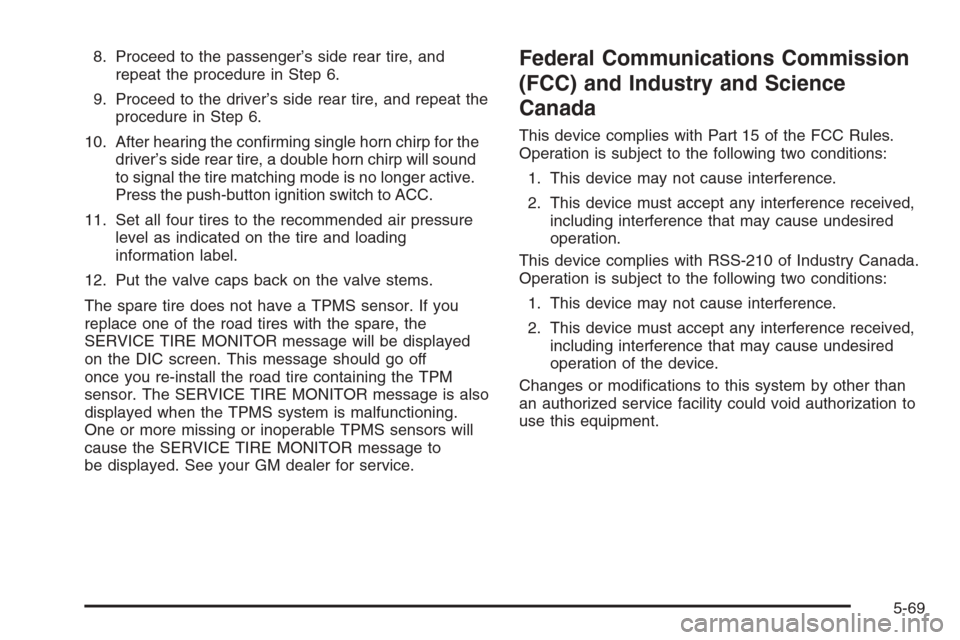
8. Proceed to the passenger’s side rear tire, and
repeat the procedure in Step 6.
9. Proceed to the driver’s side rear tire, and repeat the
procedure in Step 6.
10. After hearing the con�rming single horn chirp for the
driver’s side rear tire, a double horn chirp will sound
to signal the tire matching mode is no longer active.
Press the push-button ignition switch to ACC.
11. Set all four tires to the recommended air pressure
level as indicated on the tire and loading
information label.
12. Put the valve caps back on the valve stems.
The spare tire does not have a TPMS sensor. If you
replace one of the road tires with the spare, the
SERVICE TIRE MONITOR message will be displayed
on the DIC screen. This message should go off
once you re-install the road tire containing the TPM
sensor. The SERVICE TIRE MONITOR message is also
displayed when the TPMS system is malfunctioning.
One or more missing or inoperable TPMS sensors will
cause the SERVICE TIRE MONITOR message to
be displayed. See your GM dealer for service.Federal Communications Commission
(FCC) and Industry and Science
Canada
This device complies with Part 15 of the FCC Rules.
Operation is subject to the following two conditions:
1. This device may not cause interference.
2. This device must accept any interference received,
including interference that may cause undesired
operation.
This device complies with RSS-210 of Industry Canada.
Operation is subject to the following two conditions:
1. This device may not cause interference.
2. This device must accept any interference received,
including interference that may cause undesired
operation of the device.
Changes or modi�cations to this system by other than
an authorized service facility could void authorization to
use this equipment.
5-69
Page 385 of 480
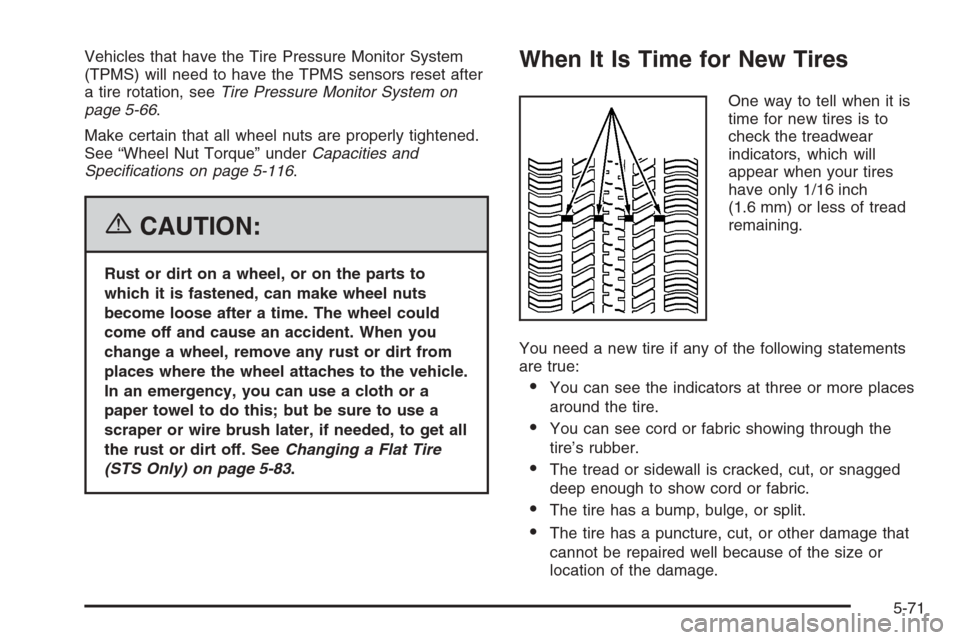
Vehicles that have the Tire Pressure Monitor System
(TPMS) will need to have the TPMS sensors reset after
a tire rotation, seeTire Pressure Monitor System on
page 5-66.
Make certain that all wheel nuts are properly tightened.
See “Wheel Nut Torque” underCapacities and
Speci�cations on page 5-116.
{CAUTION:
Rust or dirt on a wheel, or on the parts to
which it is fastened, can make wheel nuts
become loose after a time. The wheel could
come off and cause an accident. When you
change a wheel, remove any rust or dirt from
places where the wheel attaches to the vehicle.
In an emergency, you can use a cloth or a
paper towel to do this; but be sure to use a
scraper or wire brush later, if needed, to get all
the rust or dirt off. SeeChanging a Flat Tire
(STS Only) on page 5-83.
When It Is Time for New Tires
One way to tell when it is
time for new tires is to
check the treadwear
indicators, which will
appear when your tires
have only 1/16 inch
(1.6 mm) or less of tread
remaining.
You need a new tire if any of the following statements
are true:
You can see the indicators at three or more places
around the tire.
You can see cord or fabric showing through the
tire’s rubber.
The tread or sidewall is cracked, cut, or snagged
deep enough to show cord or fabric.
The tire has a bump, bulge, or split.
The tire has a puncture, cut, or other damage that
cannot be repaired well because of the size or
location of the damage.
5-71
Page 421 of 480
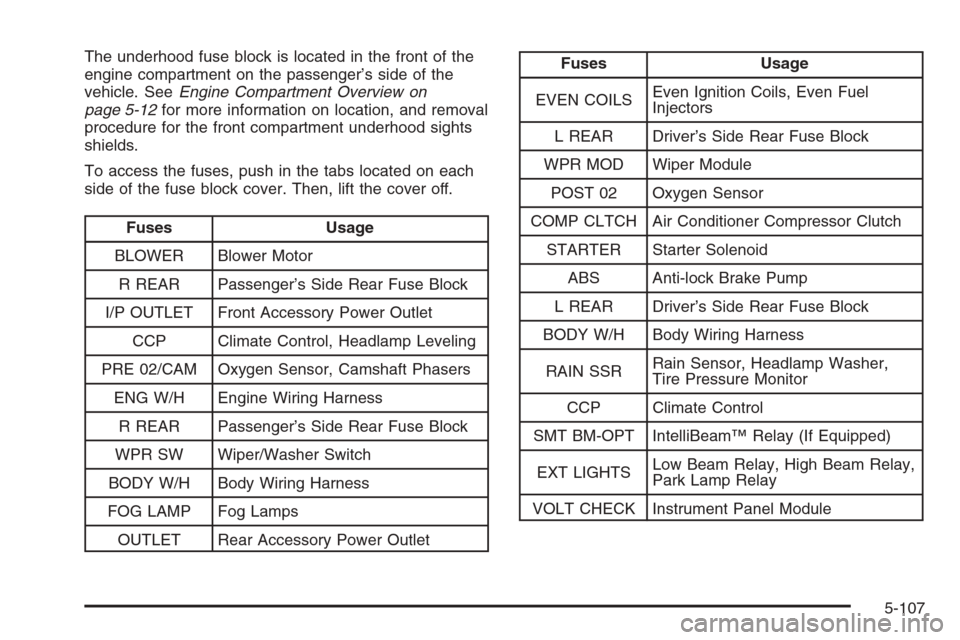
The underhood fuse block is located in the front of the
engine compartment on the passenger’s side of the
vehicle. SeeEngine Compartment Overview on
page 5-12for more information on location, and removal
procedure for the front compartment underhood sights
shields.
To access the fuses, push in the tabs located on each
side of the fuse block cover. Then, lift the cover off.
Fuses Usage
BLOWER Blower Motor
R REAR Passenger’s Side Rear Fuse Block
I/P OUTLET Front Accessory Power Outlet
CCP Climate Control, Headlamp Leveling
PRE 02/CAM Oxygen Sensor, Camshaft Phasers
ENG W/H Engine Wiring Harness
R REAR Passenger’s Side Rear Fuse Block
WPR SW Wiper/Washer Switch
BODY W/H Body Wiring Harness
FOG LAMP Fog Lamps
OUTLET Rear Accessory Power Outlet
Fuses Usage
EVEN COILSEven Ignition Coils, Even Fuel
Injectors
L REAR Driver’s Side Rear Fuse Block
WPR MOD Wiper Module
POST 02 Oxygen Sensor
COMP CLTCH Air Conditioner Compressor Clutch
STARTER Starter Solenoid
ABS Anti-lock Brake Pump
L REAR Driver’s Side Rear Fuse Block
BODY W/H Body Wiring Harness
RAIN SSRRain Sensor, Headlamp Washer,
Tire Pressure Monitor
CCP Climate Control
SMT BM-OPT IntelliBeam™ Relay (If Equipped)
EXT LIGHTSLow Beam Relay, High Beam Relay,
Park Lamp Relay
VOLT CHECK Instrument Panel Module
5-107
Page 422 of 480

Fuses Usage
ECM/TCMEngine Control Module,
Transmission Control Module,
Easy Key Module, Instrument
Panel Cluster
SPARE Spare
SPARE Spare
LT PARKDriver’s Side Park Lamp, Driver’s
Side Taillamp
LIC DIMMINGLicense Plate, Instrument
Panel Dimming
IPM ALDLInstrument Panel Module Assembly
Line Data Link Connector
HUDHeads-Up Display, Column
Lock Module
V8 ECMV8 Engine Control Module,
Evap. Solenoid
ABS Anti-lock Brake Controller
STR RLY Starter Relay
WASH
NOZ/AQSHeated Washer Nozzles, Air
Quality SensorFuses Usage
ODD COILSOdd Ignition Coils, Odd
Fuel Injectors
TCM IPCTransmission Control Module,
Instrument Panel, Engine Control
SPARE Spare
MAF Mass Air Flow Sensor
HIGH FAN Cooling Fan - High Speed
LOW FAN Cooling Fan - Low Speed
RT PARKPassenger’s Side Park Lamp,
Right Taillamp
HORN Horn
LT HI BEAM Driver’s Side Headlamp High Beam
LT LOW BEAM Driver’s Side Headlamp Low Beam
RT LOW BEAMPassenger’s Side Headlamp
Low Beam
RT HI BEAM Right Headlamp High Beam
HFV6 ECMHigh Feature V6 Engine
Control Module
5-108
Page 423 of 480
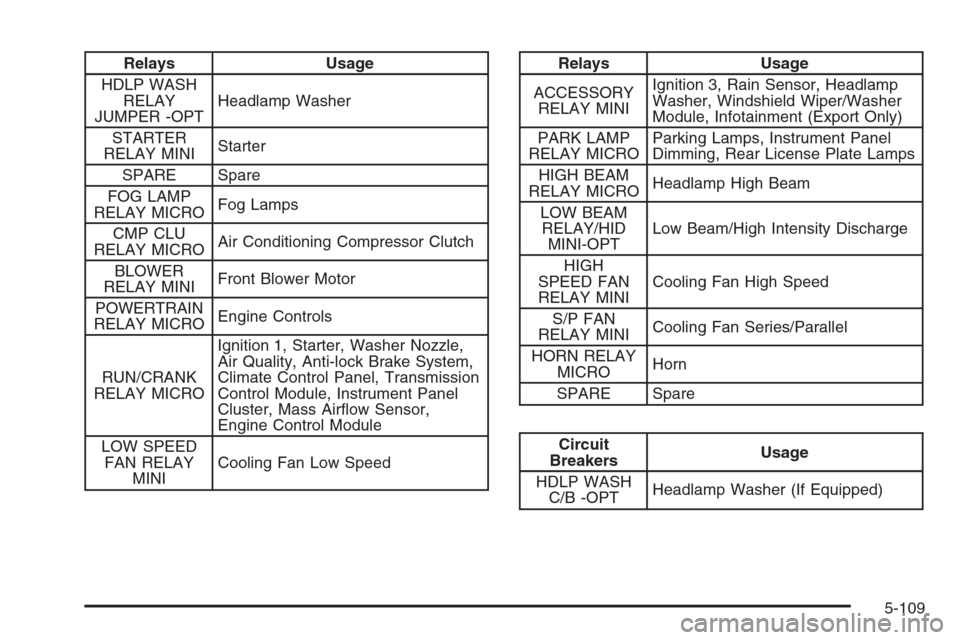
Relays Usage
HDLP WASH
RELAY
JUMPER -OPTHeadlamp Washer
STARTER
RELAY MINIStarter
SPARE Spare
FOG LAMP
RELAY MICROFog Lamps
CMP CLU
RELAY MICROAir Conditioning Compressor Clutch
BLOWER
RELAY MINIFront Blower Motor
POWERTRAIN
RELAY MICROEngine Controls
RUN/CRANK
RELAY MICROIgnition 1, Starter, Washer Nozzle,
Air Quality, Anti-lock Brake System,
Climate Control Panel, Transmission
Control Module, Instrument Panel
Cluster, Mass Air�ow Sensor,
Engine Control Module
LOW SPEED
FAN RELAY
MINICooling Fan Low SpeedRelays Usage
ACCESSORY
RELAY MINIIgnition 3, Rain Sensor, Headlamp
Washer, Windshield Wiper/Washer
Module, Infotainment (Export Only)
PARK LAMP
RELAY MICROParking Lamps, Instrument Panel
Dimming, Rear License Plate Lamps
HIGH BEAM
RELAY MICROHeadlamp High Beam
LOW BEAM
RELAY/HID
MINI-OPTLow Beam/High Intensity Discharge
HIGH
SPEED FAN
RELAY MINICooling Fan High Speed
S/P FAN
RELAY MINICooling Fan Series/Parallel
HORN RELAY
MICROHorn
SPARE Spare
Circuit
BreakersUsage
HDLP WASH
C/B -OPTHeadlamp Washer (If Equipped)
5-109
Page 426 of 480

Driver’s Side
Fuses Usage
AMP Ampli�er
INTERCOOLER
PUMP (OPT)Intercooler Pump (Option)
THEFT/
SHIFTERTheft Sensors, Auto Shifter,
Power Sounder
MR-RTD MOD
(OPT)Magnetic Ride Control
Module (Option)
REAR DR MOD Rear Door Modules
ELC SOL
(OPT)Automatic Level Control, Exhaust
Solenoid (Option)
DRIVER DR
MODDriver Door Module
TV/VICS Infotainment (Export Only)Fuses Usage
REAR HTD
SEATSRear Heated Seats
SPARE Spare
SPARE Spare
IGN3Front Passenger Heated Seat, Auto
Shifter, Occupant Protection
RR SHLF
SPEAKERRear Shelf Speaker
DPM Memory Seat, Lumbar
TRUNK DR
VALETTrunk Release, Valet Lockout
Switch
REVERSE
LAMPReverse Lamps, Rear Parking Aid,
Inside Rearview Mirror
5-112